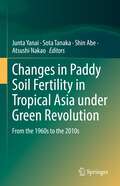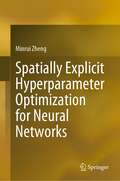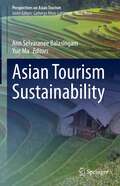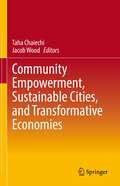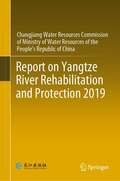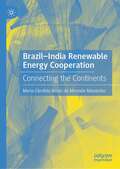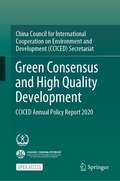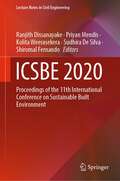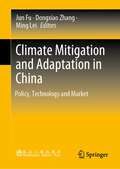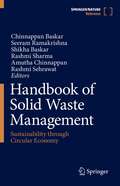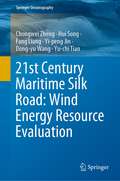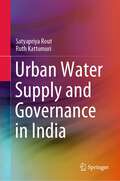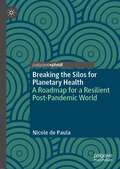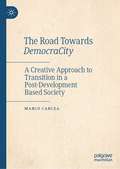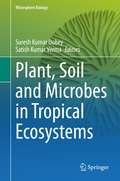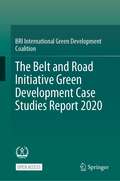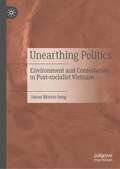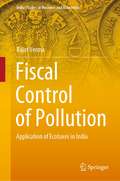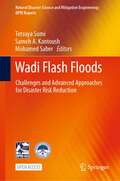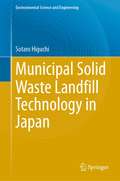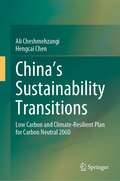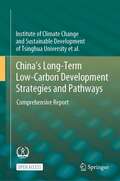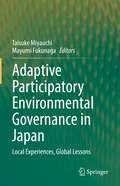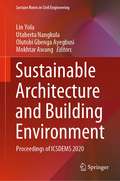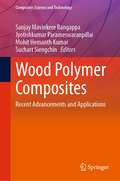- Table View
- List View
Changes in Paddy Soil Fertility in Tropical Asia under Green Revolution: From the 1960s to the 2010s
by Junta Yanai Sota Tanaka Shin Abe Atsushi NakaoThis book investigates the effect of the Green Revolution (GR) on long-term changes in the fertility status of paddy soils in tropical Asia. While information on long-term changes in soil fertility status are rather limited due to difficulties in obtaining past data or samples for comparison, this investigation on temporal changes in soil fertility is possible by comparing fertility status in the 2010s, which the authors examined recently, with those from the 1960s, when GR was initiated, which was reported by Kawaguchi & Kyuma (1977). More than 220 paddy soils collected from Thailand, the Philippines, Malaysia, Bangladesh, and Indonesia were analyzed for their physicochemical properties as well as total and available fractions of plant macro- and micro- essential elements, and their temporal changes were examined in addition to their spatial variation in each country. The most significant change was a drastic increase of available phosphorus in soils, possibly due to fertilization after the GR. Changes in organic matter, pH, and other nutrients were relatively small. A considerable decrease in the content of some micronutrients was also observed. Long-term studies on soil fertility status in the past and present will be useful to establish soil/fertilizer management for sustainable rice production in the future. This book is an essential reading for soil scientists, agricultural scientists, environmental scientists, as well as policymakers and nongovernmental officers such as FAO.
Spatially Explicit Hyperparameter Optimization for Neural Networks
by Minrui ZhengNeural networks as the commonly used machine learning algorithms, such as artificial neural networks (ANNs) and convolutional neural networks (CNNs), have been extensively used in the GIScience domain to explore the nonlinear and complex geographic phenomena. However, there are a few studies that investigate the parameter settings of neural networks in GIScience. Moreover, the model performance of neural networks often depends on the parameter setting for a given dataset. Meanwhile, adjusting the parameter configuration of neural networks will increase the overall running time. Therefore, an automated approach is necessary for addressing these limitations in current studies. This book proposes an automated spatially explicit hyperparameter optimization approach to identify optimal or near-optimal parameter settings for neural networks in the GIScience field. Also, the approach improves the computing performance at both model and computing levels. This book is written for researchers of the GIScience field as well as social science subjects.
Asian Tourism Sustainability (Perspectives on Asian Tourism)
by Yue Ma Ann Selvaranee BalasingamThis book brings together a collection of chapters that investigate sustainable tourism development in different Asian contexts; from stakeholders’ perspectives, existing issues in the market, as well as the impacts of COVID-19 on tourism. It highlights the importance of tourism sustainability in Asia. Specifically, this book examines these themes by examples related to Asian tourism such as; social-cultural impact of sustainable growth, environmental constraints and policies, community engagement, moral limits of the market, stakeholders’ participation in tourism development, the hindered interaction between foreign tourists and local community, impact of the pandemic and proposed ways forward. This edited volume substantiates this by using evidence of quantitative, qualitative and mixed methods approaches aligned with empirical data to show sustainable efforts and impacts. This book is of interest to researchers and practitioners as it offers timely understandings of sustainable tourism from multiple perspectives within the Asian context.
Community Empowerment, Sustainable Cities, and Transformative Economies
by Jacob Wood Taha ChaiechiThis edited volume presents the conference papers from the 1st International Conference on Business, Economics, Management, and Sustainability (BEMAS), organized by the Centre for International Trade and Business in Asia (CITBA) at James Cook University.This book argues that the orthodox methods of external risks, climate change adaptation plans, and sustainable economic growth in cities are no longer adequate. These methods, so far, have not only ignored the ongoing structural changes associated with economic development but also failed to account for evolving industries’ composition and the emergence of new comparative advantages and skills. Specifically, this book looks at the vulnerable communities and exposed areas, particularly in urban areas, that tend to experience higher susceptibility to external risks (such as climate change, natural disasters, and public health emergencies) have been largely ignored in incremental adaptation plans. Vulnerable communities and areas not only require different adaptive responses to climate risk but also possess unlocked adaptive capacity that can motivate different patterns of sustainable development to achieve the goals of the 2030 Agenda. It is essential, therefore, to view transformative growth and fundamental reorientation of economic resources as integral parts of the solution. Social disorganisation and vulnerability are other undesired outcomes of the unpredictable and widespread external economic shocks. This is due to a sudden and tough competition between members of society to acquire precious resources, most of which may be depleted during unprecedented events such as natural disasters or pandemics resulting in an even more chaotic and disorganised conditions.
Report on Yangtze River Rehabilitation and Protection 2019
by CWRCThis book summarizes the achievements and experience of the Yangtze River rehabilitation and protection, analyzes the new situation and requirements of the Yangtze River rehabilitation and protection, and discusses the main issues and their solution alternatives for the Yangtze River rehabilitation and protection efforts. The Yangtze River, respected as the mother river of the Chinese nation, contributes immensely toward the socioeconomic development of China and braces up the national strategies such as the development of the Yangtze River Economic Belt and the integrated development of the Yangtze River Delta, etc. Whether the Yangtze River is under good stewardship has implications on not only the wellbeing of more than 400 million inhabitants in the basin, but also in broader sense the overall sustainability of socioeconomic development of the whole country. This book which has two parts, provides a multidirectional analysis of Yangtze River rehabilitation and protection. The first part explores the stages, achievements, and the future of the Yangtze rehabilitation and protection. Major issues existing in Yangtze River Basin rehabilitation and protection are discussed in the second part. Many pictures, charts, and diagrams are involved providing an understanding of the situation of Yangtze River Basin.
Brazil-India Renewable Energy Cooperation: Connecting the Continents
by Maria Cândida Arrais de Miranda MousinhoThe book is a study of the cooperation of Brazil and India on renewable energy. It is based on a research project on the energy sector of both the countries. It discusses the agreements in the energy sector between the two countries and the renewable energy policies developed in four decades. A scientific and technological mapping, a brief study of competitiveness and a primary research were carried out in order to find out the weaknesses and the opportunities for cooperation in renewable energies. This Publication will undoubtedly provoke the reader to reflect on the importance of cooperation given the growing protectionism not only in terms of energy security, but also in terms of investments in new technologies considering energy transition scenario. For Brazil and India, intensifying the dialogue is more than a strategy of visibility and the search for greater space in worldwide geopolitics.
Green Consensus and High Quality Development: CCICED Annual Policy Report 2020
by CCICEDThis open access book is based on the research outputs of China Council for International Cooperation on Environment and Development (CCICED) in 2020. It covers major topics of Chinese and international attention regarding green development, such as climate, biodiversity, ocean, BRI, urbanization, sustainable production and consumption, technology, finance, value chain, and so on. It also looks at the progress of China’s environmental and development policies,and the impacts from CCICED. This is a highly informative and carefully presented book, providing insight for policy makers in environmental issues.
ICSBE 2020: Proceedings of the 11th International Conference on Sustainable Built Environment (Lecture Notes in Civil Engineering #174)
by Ranjith Dissanayake Priyan Mendis Kolita Weerasekera Sudhira De Silva Shiromal FernandoThis book highlights the latest knowledge and innovations in the field of civil engineering and construction industry striving for a sustainable built environment. It includes recent innovative findings from the proceedings of the 11th ICSBE 2020 under the themes of sustainable tall buildings, sustainable bridge construction and maintenance, waste in construction industry, sustainable manufacturing and recycling, disaster risk reduction for sustainable built environment, green innovations and entrepreneurship, sustainable water management in developing countries, water pollution and CKDu, sustainable urban environment and social well-being, and many greener and sustainable resource and energy-efficient innovative research findings.
Climate Mitigation and Adaptation in China: Policy, Technology and Market
by Jun Fu Dongxiao Zhang Ming LeiClimate change is a huge challenge to humanity in the 21th century. In view of China’s recent pledge to the international community to peak carbon emissions before 2030 and achieve carbon neutrality by 2060, this book examines climate mitigation and adaptation efforts in China through the prism of the steel sector, and it does so from three interrelated perspectives, i.e., policy, technology, and market. The book argues that in developing the country’s strategy towards green growth, over the years there has been a positive and interactive relationship between China’s international commitments and domestic agenda setting in mitigation and adaptation to the impact of climate change. To illustrate China’s efforts, two special areas, i.e., carbon capture, utilization and storage (CCUS) and emissions-trading system (ETS), have received focused examination. Along the spectrum of low-carbon, zero-carbon, and negative-carbon strategies, this study ends with a simulation model which outlines different policy scenarios, challenges, and uncertainties, as China moves further on, trying to achieve carbon neutrality in 2060. The book will be of interest to scholars, policy-makers, and business executives who want to understand China’s growing role in the world.
Handbook of Solid Waste Management: Sustainability through Circular Economy
by Seeram Ramakrishna Shikha Baskar Chinnappan Baskar Rashmi Sharma Amutha Chinnappan Rashmi SehrawatThe issue and finding the green solution of Solid Waste Management are important challenges throughout the world. This book explores cutting edge developments in Circular Economy and Sustainability on Solid Waste Management, current research perspectives, existing problems on solid waste management system, industrial development and the latest green methodology for in Solid Waste conversion and regenerate products and materials, environmental solutions, social awareness and development on solid waste management and the future perspectives of Circular Economy for industrial revolution 4.0 with the mission of green chemistry and engineering on solid waste management. It focuses on chapters from different researchers, faculty members, scientists and engineers, industrialist and experts from different countries working on the Circular Economy on Solid Waste Management. It also features the importance of integration of multi-disciplinary research fields on Circular Economy for Sustainable Development. It provides latest development in and current research perspectives, technology development, and critical thinking and societal requirements and development on Circular Economy of Solid Waste Management to researchers, scientists, engineers, environmental managers, policy makers, and Experts of Energy Division of Government and Private Organization and Industries.^
21st Century Maritime Silk Road: Wind Energy Resource Evaluation (Springer Oceanography)
by Chongwei Zheng Hui Song Fang Liang Yi-peng Jin Dong-yu Wang Yu-chi TianThis book aims to establish a wind energy evaluation system, to provide scientific reference for site selection, daily operation and long-term planning of wind power generation, thus to make contribution to breaking the shackles of power shortage. Firstly, it presents the advantages and disadvantages of offshore wind power, then further discusses about the status quo and challenges for wind power programs along the Maritime Silk Road and offer suggestions. A wind energy evaluation system was proposed with the Maritime Silk Road as a case study, including climatic features of wind power (temporal-spatial distribution), long-term climatic trend and mechanism, short-term forecast of wind energy, mid- and long-term projection of wind energy, technology of wind energy evaluation on key point or vital region and offshore wind energy dataset construction, to provide systematic and scientific reference for wind power evaluation and utilization.This book is one of the series of publications on 21st century Maritime Silk Road (shortened as “Maritime Silk Road”). It covers the characteristics of the marine environment and marine renewable energy, remote islands and reefs construction, climate change, early warning of wave disasters, legal escort, marine environment and energy big data construction, etc., contributing to the safe and efficient construction of the Maritime Silk Road. It aims to improve our knowledge of the ocean, thus, to improve the capacity for marine construction, enhance the viability of remote islands and reefs, ease the energy crisis and protect the ecological environment, improve the quality of life of residents along the Maritime Silk Road, and protect the rights, interests of the countries and regions participating in the construction of the Maritime Silk Road. It is a valuable reference for decision-makers, researchers, and marine engineers working in the related fields.
Urban Water Supply and Governance in India
by Satyapriya Rout Ruth KattumuriThis book investigates institutional dimensions of urban water supply in India, with a specific focus on institutional capabilities to provide drinking water to urban households in an efficient, equitable and sustainable manner. This book has been developed through empirical research within the context of growing urbanisation and increasing water needs of Indian cities, and the wider developmental goal of achieving universal and equitable access to safe and affordable water for all – as envisaged in goal 6 of the SDGs.This study revolves around three important aspects of urban water supply and governance. Firstly, it attempts to understand household water service delivery scenarios in urban India, drawing from case studies based on our household survey in four cities – Ahmedabad, Bangalore, Kochi and Hyderabad. Secondly, it examines the question of existing socio-economic inequality and access to water in an urban context in India. While dealing with the issue of inequality and access to water, it attempts to explore the question of whether access to water and water scarcity is socially neutral; whilst also analysing the mechanisms employed by the urban poor to manage their daily water needs. Thirdly, this book explores the role of institutions for efficient and effective delivery of water in urban India. The institutional analysis from a comparative perspective provides important insights to guide current reforms in domestic water supply in India, especially in a neo-liberal context. The book is a valuable resource for academicians, policy makers and practitioners involved in water governance in general and domestic (drinking) water supply in particular. Besides, it is of great interest to those working in the area of urban development, urban planning and household water management. The book is an outcome of a collaborative research project by the authors sponsored jointly by University Grants Commission (UGC), New Delhi and UK-India Education and Research Initiative (UKIERI).
Breaking the Silos for Planetary Health: A Roadmap for a Resilient Post-Pandemic World
by Nicole de PaulaThis book translates the latest theoretical perspectives on the emerging field of Planetary Health Studies into the practical reality of global political decision makers. It builds on the scientific data on the impacts of environmental change on human health to propose practical methods for operationalizing planetary health. The book maps opportunities for decision makers to break institutional silos and engage with bottom-up approaches that can transform planetary health from a global idea into a local reality. The analysis frames human health in the Anthropocene, an era in which humans have become the most powerful force affecting global ecosystems, and reveals new existential risks for humankind.Departing from ongoing multilateral efforts to promote sustainability, the author’s analysis places the agenda of planetary health on the desk of political decision makers, still underrepresented at planetary health gatherings. Given the pressing need to implement sustainable development policies, the book presents planetary health as an overarching framework for global policy targets, notably the UN Sustainable Development Goals, the Paris Agreement on Climate Change, and the post-2020 biodiversity framework under the UN Convention on Biological Diversity. The book is timely in offering a concrete road map for practitioners and researchers interested in transforming the concept of planetary health into reality. With a collection of success stories, the analysis dwells on tools for community engagement, opportunities for health professionals training, gender empowerment, digital health, and innovative ways to enhance human well-being on a changing planet.
The Road Towards DemocraCity: A Creative Approach to Transition in a Post-Development Based Society
by Marco CarceaThis book discusses the challenges faced by the homo resaliens and his need for a transition to a more sustainable social, economic, and environmental system. It fills a gap in the existing literature and provides a new perspective by changing the etymology of the word resilience: no more resiliere, but resalio. By comparing and analysing the relevant literature, the author has coined the term homo resaliens (resilient man), in contrast to the failure of the homo oeconomicus, the corruption of the homo politicus, the incompleteness of homo sustinens, and the limits of homo ecologicus. Opening a new debate in which the role of academia and res publica are fundamental to safeguard human communities and future generations, this book will greatly assist governments that wish to understand the socio-political and economic implication of resilience in terms of social inclusiveness and long term social and environmental sustainability.
Plant, Soil and Microbes in Tropical Ecosystems (Rhizosphere Biology)
by Satish Kumar Verma Suresh Kumar DubeyThis book describes the multitude of interactions between plant, soil, and micro-organisms. It emphasizes on how growth and development in plants, starting from seed germination, is heavily influenced by the soil type. It describes the interactions established by plants with soil and inhabitant microbial community. The chapters describe how plants selectively promote certain microorganisms in the rhizospheric ecozone to derive multifarious benefits such as nutrient acquisition and protection from diseases. The diversity of these rhizospheric microbes and their interactions with plants largely depend on plant genotype, soils attributes, and several abiotic and biotic factors. Most of the studies concerned with plant–microbe interaction are focused on temperate regions, even though the tropical ecosystems are more diverse and need more attention. Therefore, it is crucial to understand how soil type and climatic conditions influence the plant–soil–microbes interaction in the tropics. Considering the significance of the subject, the present volume is designed to cover the most relevant aspects of rhizospheric microbial interactions in tropical ecosystems. Chapters include aspects related to the diversity of rhizospheric microbes, as well as modern tools and techniques to assess the rhizospheric microbiomes and their functional roles. The book also covers applications of rhizospheric microbes and evaluation of prospects improving agricultural practice and productivity through the use of microbiome technologies. This book will be extremely interesting to microbiologists, plant biologists, and ecologists.
The Belt and Road Initiative Green Development Case Studies Report 2020
by BRI International Green DevelopmentThis is an Open Access book. In accordance with the 2030 Agenda for Sustainable Development, it showcases 17 projects under the framework of Belt & Road Initiative (BRI). These projects cover ninefields, namely, biodiversity and ecosystem, clean energy, clean water, sustainable transportation, solid waste treatment, sustainable consumption and production, green buildings, sustainable foodproduction and corporate social responsibility. Aiming at achieving green development, these projects, in their implementation, adhere to the concept of ecological civilization, combine China’s strict environmental protection systems and international standards, and take various measures of environmental protection based on the conditions of the local environment. These measures include joint efforts with local governments, businesses and communities, optimizating of design and construction plans, strict controling over different types of pollutants, and in situ conservation of species and ecosystems.The experience and practice of these 13 projects set an example for the latecomers.
Unearthing Politics: Environment and Contestation in Post-socialist Vietnam
by Jason Morris-JungThis book examines an important socio-political challenge to the ruling party regime in Vietnam. Vietnam has been the subject of substantial controversy and challenge to the Vietnamese party regime since market reform in the 1980s, especially since the controversy over bauxite mining in the late 2000. Using the environmental dimensions of this problem to highlight a confluence of trends disrupting the nation’s “encrusted politics”, this book open up a space for the in-depth study of the most sensitive issues, bravest activists, and most off limit struggles with the party-state in Vietnam today.
Fiscal Control of Pollution: Application of Ecotaxes in India (India Studies in Business and Economics)
by Rajat VermaThis volume analyses the process and structure of ecotaxes in India to bring forth its rationale, application and incidence on emerging environmental problems on the backdrop of the environmental issues confronted by the Indian economy. Being at infant stage in India, the concept of ecotaxes is plagued with large empirical difficulties. This book provides a holistic understanding of the complexities in the design and implementation of these fiscal instruments at the country level. After elaborating on the theory, history of its applications, the book provides an innovative methodological exercise. It examines the adequacy and relevance of ecotaxation in the Indian context, along with ensuring that the distortions due to the proposed levy are minimised. The incidence of these taxes on the households, the double dividend hypothesis and the effect on competitiveness of the producer are a few of the core themes elaborated upon in this book. This is demonstrated through a linear general equilibrium framework of Environmentally extended Social Accounting Matrix (E-SAM).The book provides material for the researchers and graduate students on the methodological structure of eco-taxes. The proposed methodological intervention could be utilised by the researchers who wish to analyse the macroeconomic impact of any tax through the framework of Social Accounting Matrix (SAM). Additionally, the process as well as the implications and nuances provided in the book will assist the policy makers to design innovative policies for dealing with environmental issues. The volume also has something for the practitioners by helping them comprehend various effects of these instruments on different stake holders of the economy and thus will be useful as a policy prescription. The three policy scenarios analysed in this study could be considered by the policymakers while attempting to design these instruments in the Indian context and thus ending the extensive reliance on the age old and grossly ineffective Command and Control (CAC) Policies.
Wadi Flash Floods: Challenges and Advanced Approaches for Disaster Risk Reduction (Natural Disaster Science and Mitigation Engineering: DPRI reports)
by Tetsuya Sumi Sameh A. Kantoush Mohamed SaberThis open access book brings together research studies, developments, and application-related flash flood topics on wadi systems in arid regions. The major merit of this comprehensive book is its focus on research and technical papers as well as case study applications in different regions worldwide that cover many topics and answer several scientific questions. The book chapters comprehensively and significantly highlight different scientific research disciplines related to wadi flash floods, including climatology, hydrological models, new monitoring techniques, remote sensing techniques, field investigations, international collaboration projects, risk assessment and mitigation, sedimentation and sediment transport, and groundwater quality and quantity assessment and management. In this book, the contributing authors (engineers, researchers, and professionals) introduce their recent scientific findings to develop suitable, applicable, and innovative tools for forecasting, mitigation, and water management as well as society development under seven main research themes as follows: Part 1. Wadi Flash Flood Challenges and Strategies Part 2. Hydrometeorology and Climate Changes Part 3. Rainfall–Runoff Modeling and Approaches Part 4. Disaster Risk Reduction and Mitigation Part 5. Reservoir Sedimentation and Sediment Yield Part 6. Groundwater Management Part 7. Application and Case Studies The book includes selected high-quality papers from five series of the International Symposium on Flash Floods in Wadi Systems (ISFF) that were held in 2015, 2016, 2017, 2018, and 2020 in Japan, Egypt, Oman, Morocco, and Japan, respectively. These collections of chapters could provide valuable guidance and scientific content not only for academics, researchers, and students but also for decision-makers in the MENA region and worldwide.
Municipal Solid Waste Landfill Technology in Japan (Environmental Science and Engineering)
by Sotaro HiguchiJapan was ahead of the rest of the world when it introduced intermediate processing of municipal waste by such means as incineration in the 1960s. Owing to the small land area of the country and the difficulty in securing landfill sites, the incineration ratio of municipal combustible waste had reached 100% by the 1990s. Along with the landfill of incineration residues, proprietary technologies such as high salt leachate treatment, desalination treatment, by-product recycling, a focus on the resource of incineration residues, sea surface landfill sites, and covered type landfill sites have spread and developed since then. This book describes the introduction of incineration facilities starting in the 1960s, landfill technology, and issues arising after 1990 following the introduction of the facilities. The necessity of a total system from incineration to landfill is explained as well. The volume is a valuable resource for countries that plan to introduce intermediate processing such as incineration and for countries that are developing a waste management policy.
China's Sustainability Transitions: Low Carbon and Climate-Resilient Plan for Carbon Neutral 2060
by Ali Cheshmehzangi Hengcai ChenThis book considers the impact of global climate change, advocating to promote sustainable development from the perspective of low carbon and climate resilience, by reducing carbon emissions in different aspects of urban and regional development. As the world's largest emitter of carbon dioxide, China is continuously exploring a sustainable path to achieve the momentous goal of 2060 carbon neutrality. In addition, this book reviews and summarizes China's green development and predicts the transformation of China's carbon emission and energy structure before and after the peak of carbon emission in 2030. It examines the role of governance in decarbonization efforts, focusing on decision making processes, policies and regulations, as well as the significance of regions, cities, and communities. This book highlights typical methods of implementing and achieving low carbon development in light of China's practical situation, which helps to resolve some of the problems that may arise in achieving the carbon neutral goal. Therefore, this book is suitable for the reference of scholars in low-carbon environment science, sustainable urban development, and other related fields. It also provides inspiration for China's medium and long-term sustainable development plans in the future.
China's Long-Term Low-Carbon Development Strategies and Pathways: Comprehensive Report
by Institute of Climate Change and Sustainable Development of Tsinghua University et al.This open access book introduces a multi-disciplinary and comprehensive research on China's long-term low-carbon emission strategies and pathways. After comprehensively considering China’s own socioeconomic conditions, policy design, energy mix, and other macro-development trends and needs, the research team has proposed suggestions on China’s low-carbon development strategies and pathways until 2050, with required technologies and policies in order to realize the goals of building a great modern socialist country and a beautiful China. These achievements are in conjunction with the climate goals set in the Paris Agreement alongside Global Sustainable Development. The authors hope that the research findings can serve as a reference for all sectors of Chinese society in their climate research efforts, offer support for the formulation and implementation of china’s national low-carbon development strategies and policies, and help the world to better understand China’s story in the general trend of global green and low-carbon development.
Adaptive Participatory Environmental Governance in Japan: Local Experiences, Global Lessons
by Taisuke Miyauchi Mayumi FukunagaThis book contributes to the theoretical and practitioner literature in environmental governance and sustainability of natural resources by linking case studies of the roles of narratives to the three key practices in local environmental governance: socio-political legitimacy in participation; collaboratively creating stakeholder-ness, and cultivating social and ecological capabilities. It provides numerous theoretical insights on legitimacy, adaptability, narratives, process-oriented collaborative planning, and among others, using in-depth case studies from historical and contemporary environmental issues including conservation, wildlife management, nuclear and tsunami disasters, and thus community risk, recovery, and resiliency. The authors are all practitioner-oriented scientists and scholars who are involved as local stakeholders in these practices. The chapters highlight their action and participatory-action research that adds deeper insights and analyses to successes, failures, and struggles in how narratives contribute to these three dimensions of effective environmental governance. It also shows how stakeholders’ kinds of expertise, in a historical context, help to bridge expert and citizen legitimacy, as well as spatial and jurisdictional governance structures across scales of socio-political governanceOf particular interest, both within Japan and beyond, the book shares with readers how to design and manage practical governance methods with narratives. The detailed design methods include co-imagination of historical and current SESs, designing processes for collaborative productions of knowledge and perceptions, legitimacy and stakeholder-ness, contextualization of contested experiences among actors, and the creation of evaluation standards of what is effective and effective local environmental governance.The case studies and their findings reflect particular local contexts in Japan, but our experiences of multiple natural disasters, high economic growth and development, pollutions, the nuclear power plant accident, and rapidly aging society provide shared contexts of realities and provisional insights to other societies, especially to Asian societies.
Sustainable Architecture and Building Environment: Proceedings of ICSDEMS 2020 (Lecture Notes in Civil Engineering #161)
by Lin Yola Utaberta Nangkula Olutobi Gbenga Ayegbusi Mokhtar AwangThis book presents articles from the International Conference on Sustainable Design, Engineering, Management, and Sciences (ICSDEMS 2020), held in Bali, Indonesia. It highlights recent advances in civil engineering and sustainability, bringing together researchers and professionals to address the latest, most relevant issues in these areas.
Wood Polymer Composites: Recent Advancements and Applications (Composites Science and Technology)
by Sanjay Mavinkere Rangappa Jyotishkumar Parameswaranpillai Mohit Hemanth Kumar Suchart SiengchinThis book comprehensively covers the different topics of wood polymer composite materials mainly synthesis methods for the composite materials, various characterization techniques to study the superior properties and insights on potential advanced applications. It also discusses the chemistry, fabrication process, properties, applications, recycling and life cycle assessment of wood polymer composites. This is a useful reference source for both engineers and researchers working in composite materials science as well as the students attending materials science, physics, chemistry and engineering courses.
